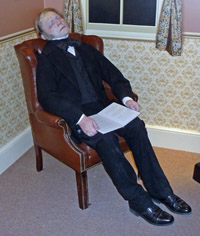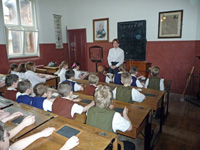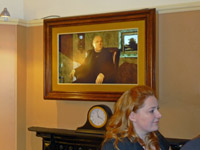News
Barton's new Wilderspin National School Museum attracts national acclaim

In the exhibition gallery at the newly opened Wilderspin National School Museum in Barton-upon-Humber, a 19th century schoolmaster sits in a very comfortable armchair, his head thrown back and fast asleep. The exhibit can be taken as a symbol for how many of the volunteers and others in the town who, for over twenty years, fought to save the building from demolition must feel—elated, but exhausted. Back in 1983, four years after the school closed in 1979, local residents had the vision to see its potential as a museum devoted to the life and achievements of the 19th century educationalist, Samuel Wilderspin, but it was not until 1993 that the Queen Street School Preservation Trust was formed and the idea took form and fund-raising began.

Wilderspin (1791—1866) worked in Scotland, Liverpool and Dublin before arriving in Barton-upon-Humber in 1844 to teach in the then newly opened Queen Street School (left), which was built with a 'step gallery' and an 'H' design to allow for boys, girls and infants to be taught separately. He promoted 'the educational value of activity and enjoyment and learning through practical experiences'. Wilderspin became a household name in his time and created an approach to infant education which is still with us today. His schools included the first playgrounds for children. As the decades past his work and reputation were forgotten, even in Barton-upon-Humber, until Rex Russell, a Barton local historian and contributor to Local History Magazine, re-discovered Wilderspin's link with the school and its national significance.

A lesson in a real Victorian classroom for children from North Lincolnshire.
When the Wilderspin National School Museum was formally opened on 23 January 2009, Rex was one of three Barton residents who were mentioned by guest speakers. The others were John French, a former town councillor, who was driven by his passion to save the building, and Dr Jim Robertson, a retired local GP and former Medical Officer of Health, who was also at the heart of the campaign to recreate some of school's original features as part of a building celebrating the work of Samuel Wilderspin. When they embarked on their campaign to save what they thought to be an important local building, little did they realise that their work would bring them into contact with historians and academics in other parts of Britain, America and Germany and that their new museum would open its doors having already acquired an international reputation, which will ensure that visitors will come from around the globe to see this 19th century school building in one of England's most beautiful towns.

A LCD-TV screen in the Wilderspin National School exhibition area disguised as a picture hanging on a wall. I was a little startled when the screen first came to life and Samuel Wilderspin began talking to me!
This is truly a remarkable museum, firmly rooted in the local community which it serves, whilst helping to make Barton-upon-Humber, situated in the shadow of the Humber Bridge, a place well worth two days of anyone's time, in terms of its historical attractions and location. The town has two Saxon churches, a Georgian and Victorian townscape, a Visitors' Centre beside the Humber and the Barton Ropery Museum, Art Gallery & Craft Centre, as well as the Wilderspin National School. All are linked by heritage walks.
Wilderspin National School Museum, Queen Street, Barton-upon-Humber, DN18 5QP open 10am–5pm (last admission 4pm), Thur–Sun, free, tel: 01652 635172. School parties are also welcome (Mon–Thur) and should pre-book via North Lincs Museum Education Service, tel: 01724 843533.
6 February 2009
